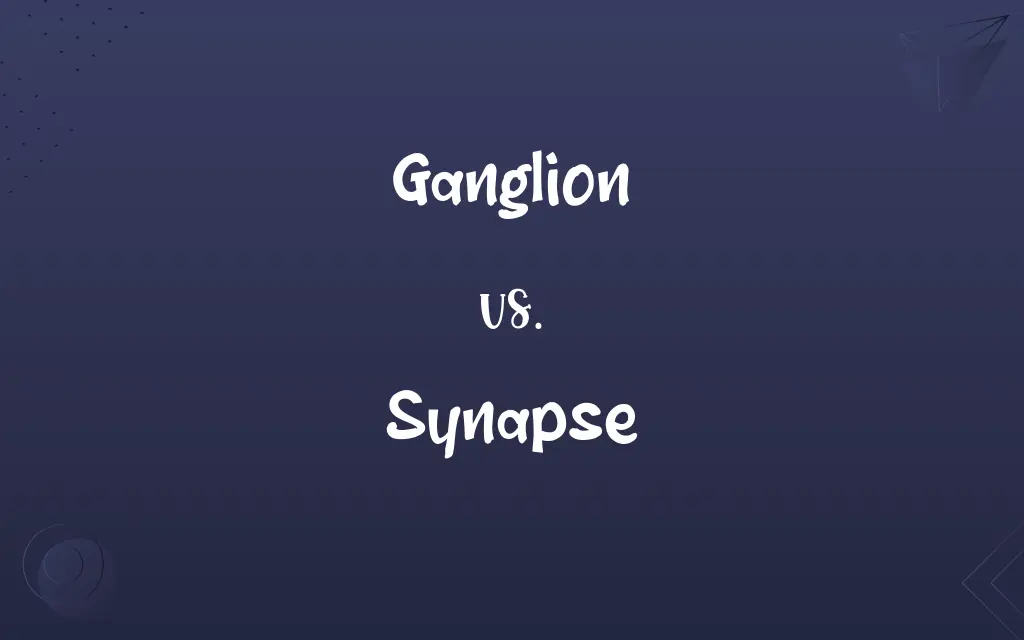Ganglion vs. Synapse: Know the Difference

By Shumaila Saeed || Published on January 5, 2024
A ganglion is a cluster of nerve cell bodies, often forming a swelling on a nerve, while a synapse is a junction where nerve impulses pass between neurons.

Key Differences
A ganglion is a group of neuron cell bodies located outside the central nervous system, serving as relay points for neural signals. A synapse, conversely, is the site where two neurons communicate, transmitting signals via chemical or electrical means.
Shumaila Saeed
Jan 05, 2024
Ganglia often appear as small swellings along nerve paths and are crucial in the peripheral nervous system. Synapses are microscopic and cannot be seen without magnification, functioning as critical communication points between neurons.
Shumaila Saeed
Jan 05, 2024
Ganglia play a key role in processing and relaying information from the body to the brain and vice versa. Synapses are essential for the transmission of nerve impulses from one neuron to another, facilitating neural communication.
Shumaila Saeed
Jan 05, 2024
There are various types of ganglia, including sensory and autonomic ganglia, each serving different functions. Synapses also vary, including chemical and electrical synapses, each with unique mechanisms for transmitting signals.
Shumaila Saeed
Jan 05, 2024
Disorders related to ganglia include ganglion cysts and neuropathies. Synaptic disorders include synaptic malfunction or degeneration, as seen in conditions like Alzheimer's disease.
Shumaila Saeed
Jan 05, 2024
ADVERTISEMENT
Comparison Chart
Function
Relay and processing of neural signals
Transmission of nerve impulses
Shumaila Saeed
Jan 05, 2024
Associated Disorders
Ganglion cysts, neuropathies
Synaptic malfunction, neurodegenerative diseases
Shumaila Saeed
Jan 05, 2024
ADVERTISEMENT
Ganglion and Synapse Definitions
Ganglion
A ganglion serves as a processing center for neural information.
The basal ganglia are involved in motor control and learning.
Shumaila Saeed
Dec 11, 2023
Synapse
A synapse is a junction where neurons communicate.
Neurotransmitters are released at the synapse to transmit signals.
Shumaila Saeed
Dec 11, 2023
Ganglion
Ganglia are key components in the peripheral nervous system.
Autonomic ganglia play a vital role in involuntary bodily functions.
Shumaila Saeed
Dec 11, 2023
Synapse
Synapses allow for the transfer of information between neurons.
Learning involves the strengthening of certain synapses.
Shumaila Saeed
Dec 11, 2023
Ganglion
Ganglia can sometimes form cysts, known as ganglion cysts.
A ganglion cyst can develop along tendons or joints.
Shumaila Saeed
Dec 11, 2023
ADVERTISEMENT
Synapse
Chemical synapses involve neurotransmitter release.
Serotonin is released at synapses in the brain.
Shumaila Saeed
Dec 11, 2023
Ganglion
A ganglion is a cluster of nerve cells forming a nerve knot.
The dorsal root ganglion contains cell bodies of sensory neurons.
Shumaila Saeed
Dec 11, 2023
Synapse
Electrical synapses transmit signals via ion channels.
Electrical synapses facilitate rapid signal transmission.
Shumaila Saeed
Dec 11, 2023
Ganglion
Ganglia can be associated with certain types of nerve pain.
Abnormalities in a ganglion can lead to neuropathic pain.
Shumaila Saeed
Dec 11, 2023
Synapse
Synaptic plasticity is crucial for memory and learning.
Synaptic plasticity refers to the ability of synapses to strengthen or weaken over time.
Shumaila Saeed
Dec 11, 2023
Ganglion
A group of nerve cells forming a nerve center, especially one located outside the brain or spinal cord.
Shumaila Saeed
Dec 10, 2023
Synapse
The junction across which a nerve impulse passes from an axon terminal to a neuron, muscle cell, or gland cell.
Shumaila Saeed
Dec 10, 2023
Ganglion
(Medicine) A benign cystic lesion resembling a tumor, occurring in a tendon sheath or joint capsule.
Shumaila Saeed
Dec 10, 2023
Synapse
The junction between the terminal of a neuron and either another neuron or a muscle or gland cell, over which nerve impulses pass.
Shumaila Saeed
Dec 10, 2023
Ganglion
An encapsulated collection of nerve cell bodies, typically linked by synapses, and often forming a swelling on a nerve fiber.
Shumaila Saeed
Dec 10, 2023
Ganglion
Any of certain masses of gray matter in the central nervous system, as the basal ganglia.
Shumaila Saeed
Dec 10, 2023
Ganglion
(transferred sense) A centre of intellectual or industrial force, activity, etc.
Shumaila Saeed
Dec 10, 2023
Synapse
The junction between two neurons (axon-to-dendrite) or between a neuron and a muscle;
Nerve impulses cross a synapse through the action of neurotransmitters
Shumaila Saeed
Dec 10, 2023
Ganglion
(pathology) A benign cystic tumour on a tendon sheath or joint capsule.
Shumaila Saeed
Dec 10, 2023
Ganglion
A mass or knot of nervous matter, including nerve cells, usually forming an enlargement in the course of a nerve.
Shumaila Saeed
Dec 10, 2023
Ganglion
A globular, hard, indolent tumor, situated somewhere on a tendon, and commonly formed by the effusion of a viscid fluid into it; - called also weeping sinew.
Shumaila Saeed
Dec 10, 2023
Ganglion
An encapsulated neural structure consisting of a collection of cell bodies or neurons
Shumaila Saeed
Dec 10, 2023
Repeatedly Asked Queries
What is a ganglion?
A group of nerve cell bodies outside the central nervous system.
Shumaila Saeed
Jan 05, 2024
What disorders are associated with ganglia?
Ganglion cysts and neuropathies.
Shumaila Saeed
Jan 05, 2024
What disorders are related to synapses?
Neurodegenerative diseases like Alzheimer's.
Shumaila Saeed
Jan 05, 2024
Can ganglia cause pain?
Yes, especially if they become inflamed or form cysts.
Shumaila Saeed
Jan 05, 2024
Do synapses change over time?
Yes, they undergo plasticity, affecting learning and memory.
Shumaila Saeed
Jan 05, 2024
How do drugs affect synapses?
They can alter neurotransmitter release or reception.
Shumaila Saeed
Jan 05, 2024
What's the significance of synaptic plasticity?
It's key for adapting and learning new information.
Shumaila Saeed
Jan 05, 2024
How are synapses crucial for brain function?
They facilitate communication and processing in the brain.
Shumaila Saeed
Jan 05, 2024
What's the difference between a chemical and electrical synapse?
Chemical synapses use neurotransmitters, while electrical synapses use direct ion flow.
Shumaila Saeed
Jan 05, 2024
Share this page
Link for your blog / website
HTML
Link to share via messenger
About Author
Written by
Shumaila SaeedShumaila Saeed, an expert content creator with 6 years of experience, specializes in distilling complex topics into easily digestible comparisons, shining a light on the nuances that both inform and educate readers with clarity and accuracy.









































































